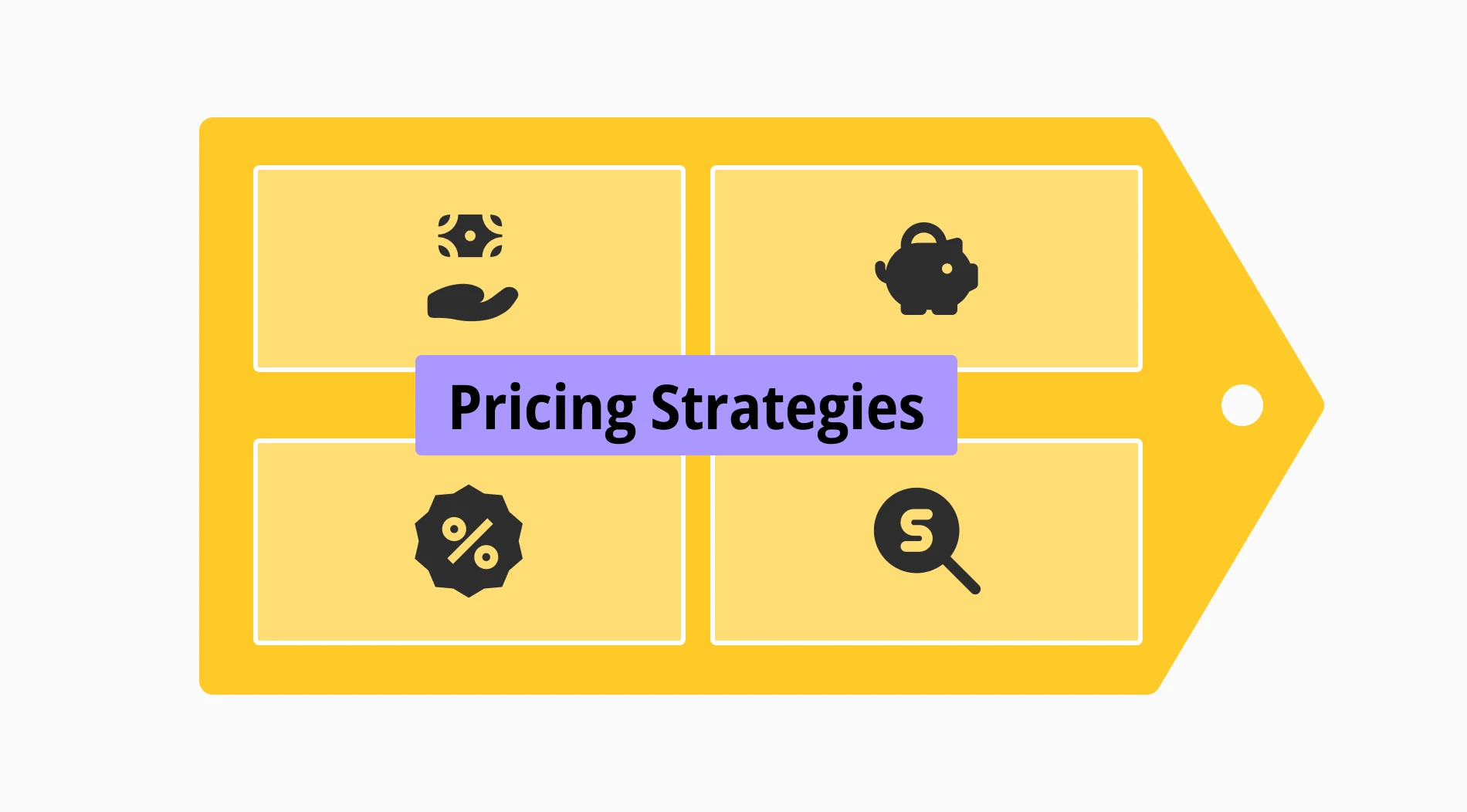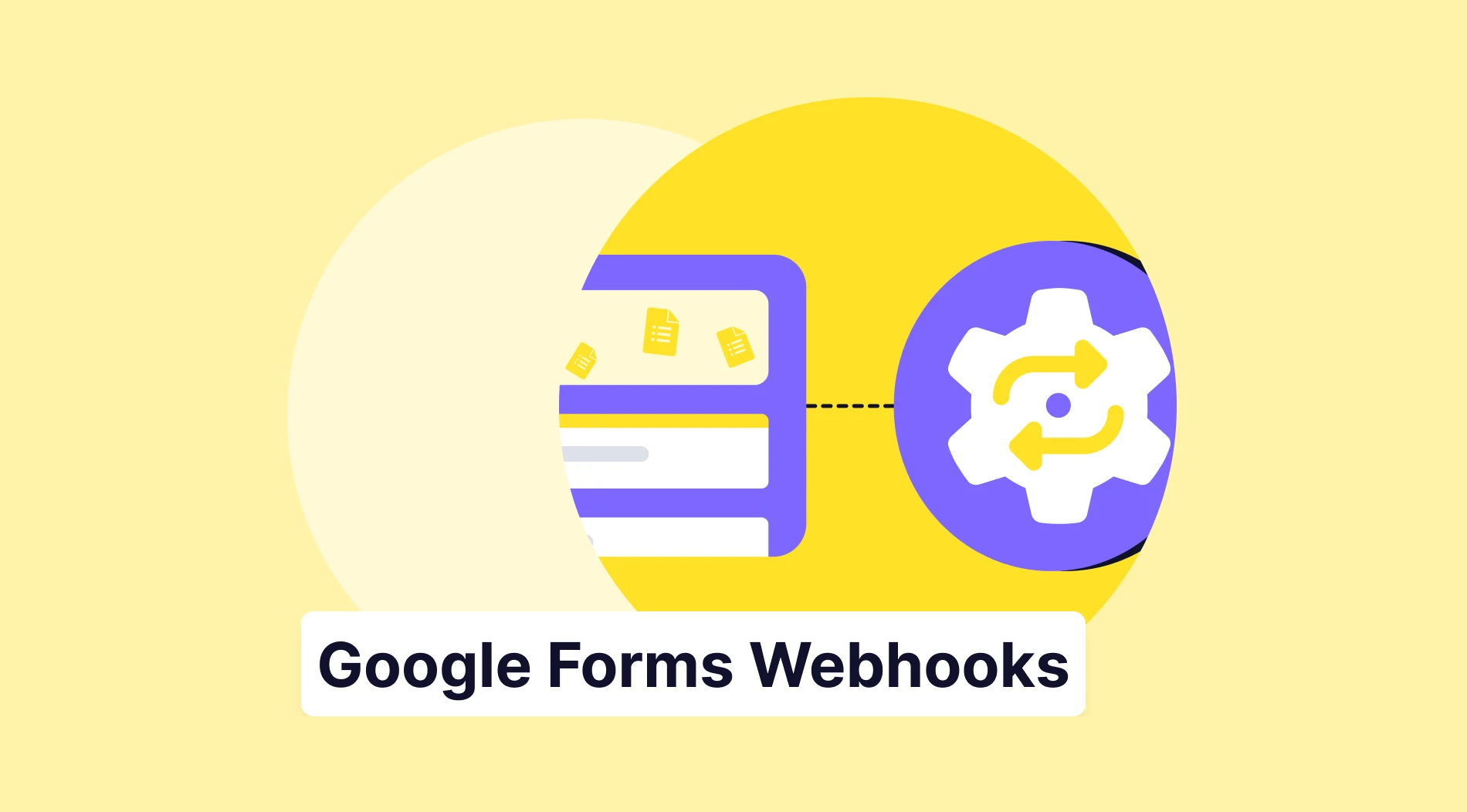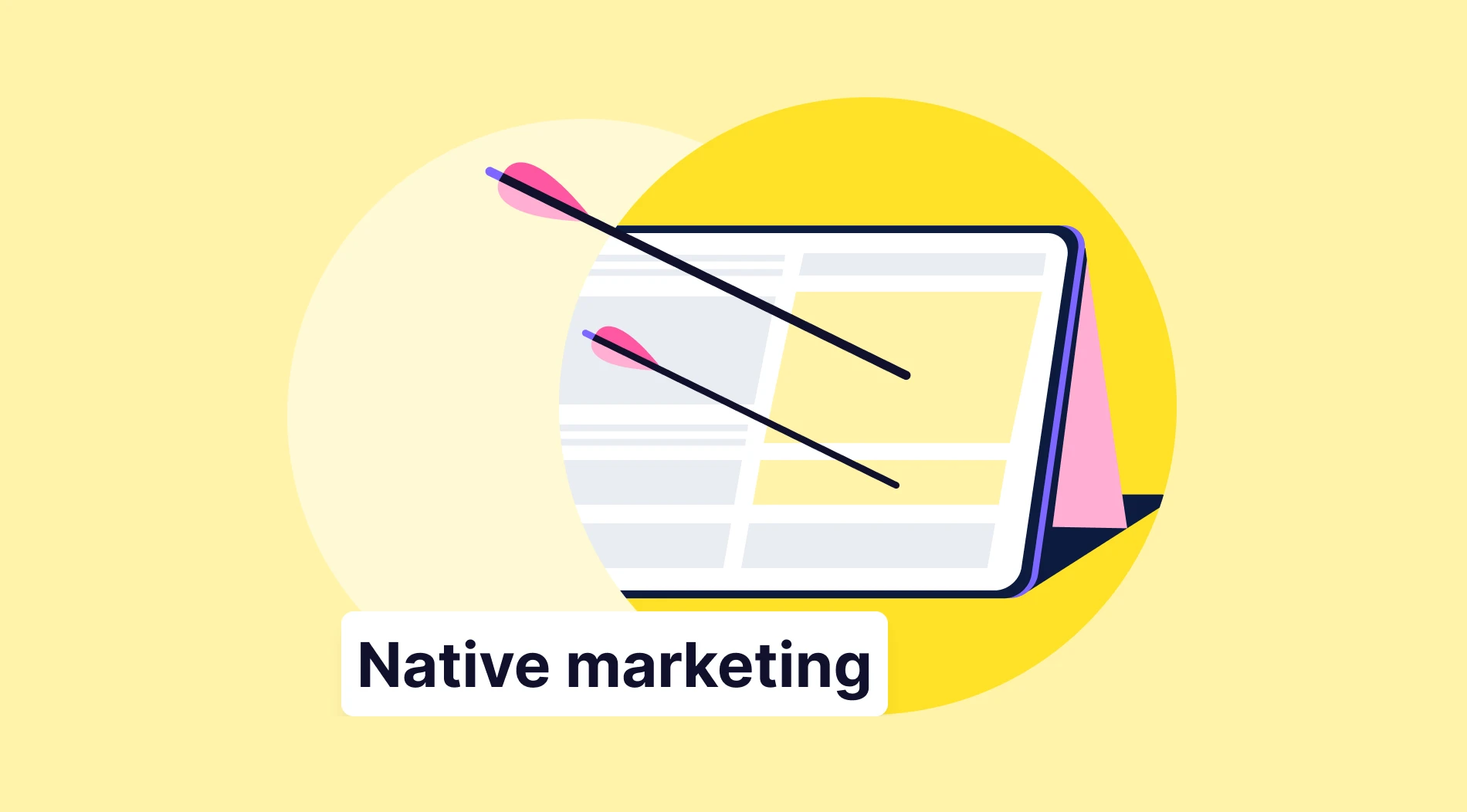In today’s competitive market, businesses need effective strategies to succeed. Many strategies and crucial tools can help your company stay profitable and competitive. Using these, you can attract customers, maximize profits, and gain an edge over competitors. Understanding and implementing effective strategies ensures your business adapts to market changes and customer preferences.
We’ll talk about one of these tools, the pricing strategies. We’ll start by explaining pricing strategies and when to use them. Then, we’ll outline the step-by-step process to build effective pricing strategies. We’ll also explore pricing strategies, real-life examples, and their advantages/disadvantages. Finally, we’ll provide answers to some frequently asked questions.
What is a pricing strategies
Pricing strategies are methods businesses use to set the prices of their products or services.
These strategies take into account factors such as production costs, market demand, competitor pricing, and customer perceptions. If you carefully consider these elements, your business can determine the optimal price points to attract customers while ensuring profits.
Different industries/sectors and markets may require different pricing strategies, but your goal should always be to balance customer satisfaction with revenue generation. Effective pricing strategies can lead to increased sales, better market positioning, and long-term success for your business.
There are several types of pricing strategies that your business can use. Common pricing strategies include cost-plus, value-based, and competitive pricing. We’ll look at each of them in detail. Each strategy has its own advantages and addresses different business models and market conditions. The right pricing strategy can attract more costumes, increase your sales volume, and enhance customer loyalty.
12 Strategies of pricing
Now that we are familiar with the concept of “pricing strategies,” let’s examine them individually. In this part, we’ll understand the differences between 12 pricing strategies. Remember, investing time and resources in developing and refining pricing strategies is essential for your long-term business success.
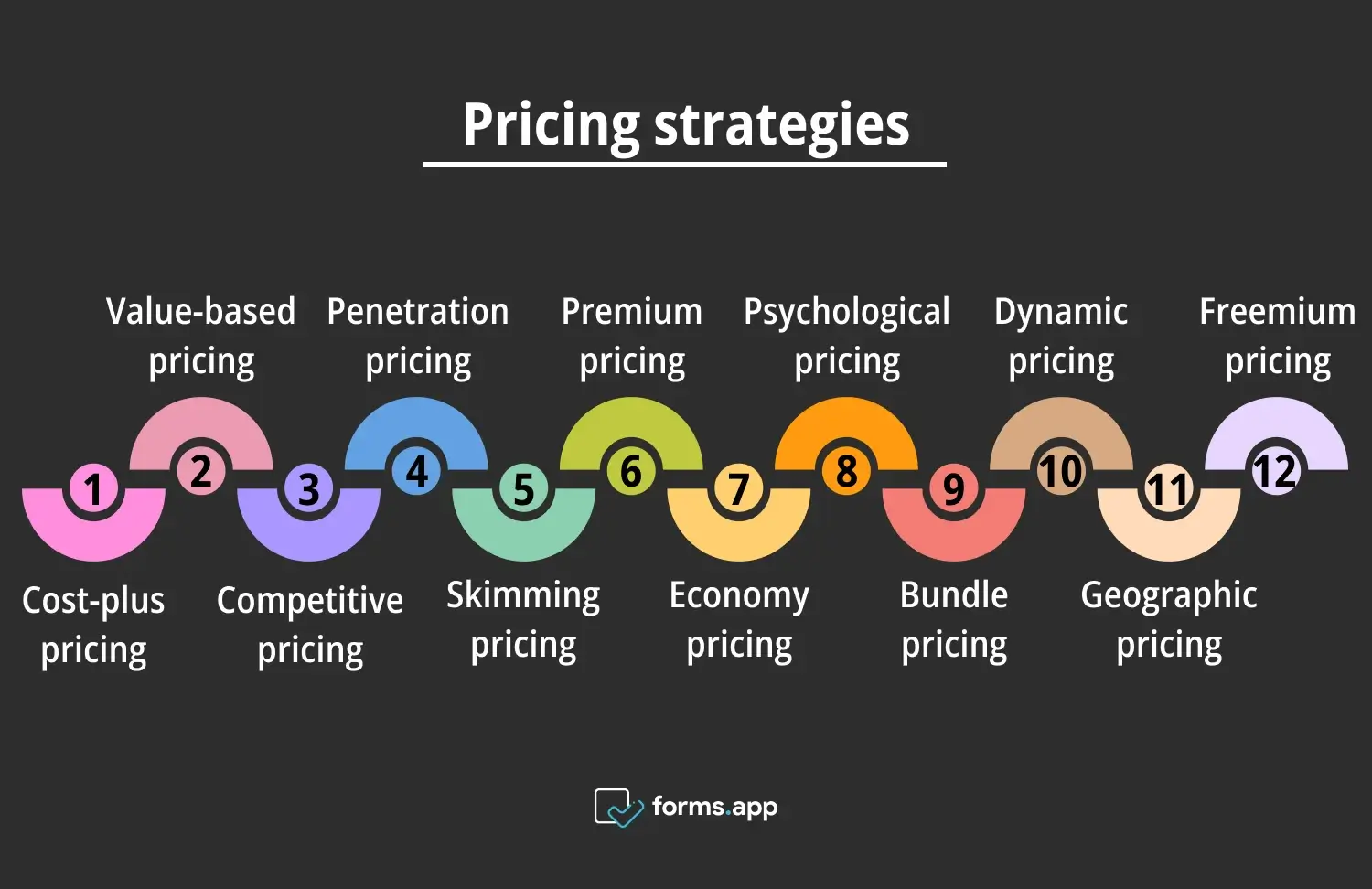
Pricing strategies
1- Cost-plus pricing
Our first strategy is cost-plus pricing. It is a straightforward method where you add a fixed percentage to the production cost to determine the selling price. This ensures that you can cover all costs and achieve a profit margin. It is easy to calculate and ensures profits if your sales volume meets expectations.
However, it does not consider market demand or competitor prices. This sometimes results in prices that are too high or too low. Despite this, you can see that cost-plus pricing is a popular strategy in industries where costs are stable and predictable.
2- Value-based pricing
Our second strategy, value-based pricing, sets prices based on the perceived value to the customer rather than the cost of production. This approach requires a deep understanding of customer needs and preferences. It allows your business to charge higher prices if the product offers unique benefits that your customers value.
This strategy is effective for different products or services, providing significant advantages over competitors. If you focus on customer value, your business can maximize profits and customer satisfaction. However, keep in mind that accurately assessing perceived value can be challenging and requires continuous market research and customer feedback.
3- Competitive pricing
The third strategy, competitive pricing, involves setting prices based on what competitors charge for similar products. This strategy ensures that your prices are in line with market expectations and can help attract price-sensitive customers. It is particularly useful in markets with many similar products where price competition is intense.
While competitive pricing strategies help to maintain market share, they can lead to price wars and reduced profit margins. Your business needs to balance competitive pricing with cost considerations and value propositions to ensure sustainability. Understanding competitor strategies and market dynamics is essential for you to achieve successful competitive pricing.
4- Penetration pricing
Penetration pricing strategy sets a low initial price to quickly attract your customers and gain market share. This strategy is very useful for new product launches or entering competitive markets. The low price helps in drawing attention and encouraging trial purchases. Once you establish your customer base, you can gradually increase the prices.
Penetration pricing can effectively disrupt markets and establish a strong presence. However, it requires significant investment and may result in initial losses. In this context, your business needs to ensure that it has the financial resources to support this strategy until it becomes profitable.
5- Skimming pricing
Skimming pricing involves setting a high initial price for a new or innovative product to maximize profits from early adopters. Over time, you can gradually reduce the price to attract a broader customer base. This strategy helps you cover development costs quickly and takes advantage of customers willing to pay a premium for the latest offerings.
Skimming pricing may work well for products with unique features or technological advancements. However, keep in mind that it may also require careful market segmentation and timing. Your business needs to manage customer expectations and potential directions to price reductions.
6- Premium pricing
Premium pricing sets high prices to create a perception of exclusivity and superior quality. This strategy targets customers who associate higher prices with better value and who are willing to pay a premium for luxury or high-standard products. Premium pricing reinforces your brand positioning and enhances the perceived value of your product/service.
It is effective in markets where brand image and quality are critical factors in purchasing decisions. However, your business needs to consistently deliver exceptional value and maintain its brand reputation to justify the high prices. Premium pricing works best for different products with strong brand quality.
7- Economy pricing
Economy pricing focuses on setting low prices to attract cost-conscious customers. This strategy relies on keeping production and marketing costs low to maintain profits. Economy pricing is common in the fast-moving consumer goods (FMCG) sector. Here, larger volumes and low margins are the norm. This approach appeals to price-sensitive customers and can drive high sales volumes.
However, efficient operations and cost control are required to ensure profits. If your business is using economy pricing, you need to focus on delivering basic value without unnecessary difficulties. Effective economy pricing depends on a thorough understanding of cost structures and customer preferences.
8- Psychological pricing
Psychological pricing uses pricing tactics that influence customer perceptions and buying behavior. Common techniques include pricing products just below a round number (e.g., $9.99 instead of $10) to make the price appear lower. Other methods involve using “buy one, get one free” offers or bundling products (another pricing strategy) at a discounted rate.
Psychological pricing leverages customer psychology to create a perception of value and savings. It can be effective in encouraging impulse purchases and increasing sales. However, your business needs to ensure that these tactics align with the overall brand strategy and do not undermine long-term profitability.
9- Bundle pricing
Bundle pricing offers multiple products or services at a discounted rate compared to purchasing each item separately. This strategy increases the perceived value and can encourage customers to buy more. It is effective for complementary products or services that you can often use together.
Bundle pricing helps increase average transaction value and can also help clear out your inventory. Your business must carefully select products to bundle and set prices reflecting a genuine discount. Effective bundle pricing requires understanding customer preferences and purchasing behavior to create attractive and valuable offers.
10- Dynamic pricing
Dynamic pricing adjusts prices in real-time based on market demand, competitors' prices, and other factors. This strategy uses algorithms and data analytics to optimize prices for maximum revenue. Dynamic pricing is common in travel, hospitality, and e-commerce industries because demand changes frequently. It lets your business respond quickly to market changes and leverage high-demand periods.
However, it also requires sophisticated technology and data analysis capabilities. Your business must also manage customer perceptions and ensure transparency to avoid potential backlash. Dynamic pricing can significantly enhance revenue management and profits if you can use it effectively. For data collection, look at data collection methods for market research.
11- Geographic pricing
Geographic pricing sets different prices for your products or services based on the geographic location of your customers. This strategy depends on changing market conditions, local economic factors, and competitive landscapes. Your company might charge higher prices in regions with higher living costs or more flexible customer bases.
On the contrary, you can set lower prices in areas with greater price sensitivity. Geographic pricing helps your business optimize revenue and target market penetration by aligning prices with local conditions. However, it requires thorough market research and can lead to complexity in pricing administration and potential customer dissatisfaction if you do not manage it transparently.
12- Freemium pricing
Freemium pricing offers basic services or products for free while charging a premium for advanced features or benefits. This strategy is popular in the software and digital services industries. Because offering free basic versions can attract a large user base here. Once users recognize your value, they may choose a premium version for enhanced functions.
Freemium pricing drives initial adoption and can lead to significant revenue from premium subscriptions. However, a clear difference between free and paid offerings is required to encourage users to update. Your business must balance between providing enough free value and encouraging premium conversions.
How to build pricing strategies
We have seen twelve different and useful pricing strategies, each with its own values and advantages. Now, we will offer 6 steps to follow if you want to use a pricing strategy effectively. These steps will help you a great deal in finding the right strategy and using it properly.
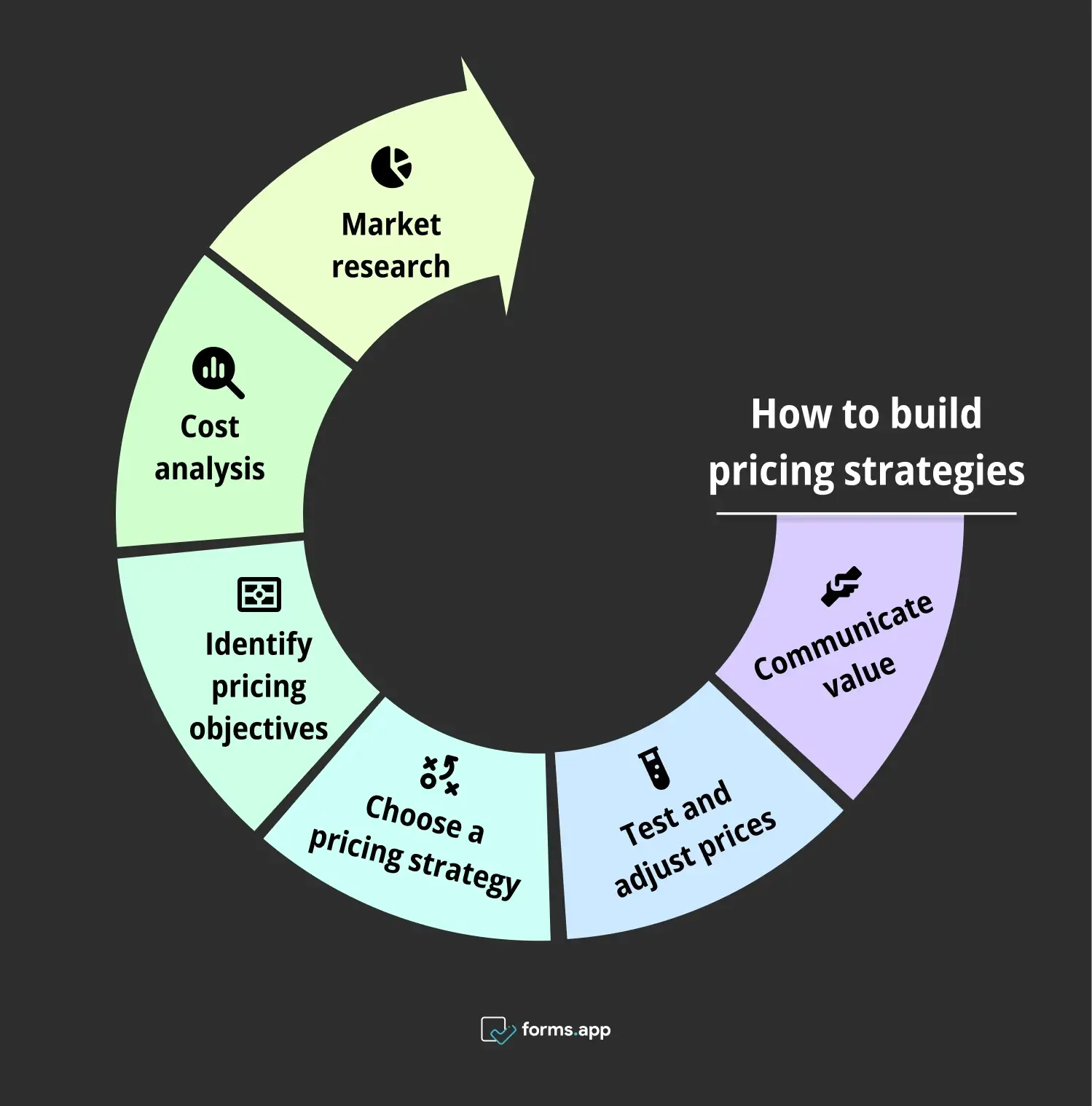
Steps for pricing strategies
Step 1: Market research
Conduct thorough market research to understand industry trends, customer preferences, and competitor pricing. Gather data on how the competitors price similar products and identify gaps in the market. Analyzing customer feedback and purchasing behavior will help you determine what your customers value most. You can use market research tools for this.
Step 2: Cost analysis
Perform a detailed cost analysis to understand your expenses before selling the product/service. This may include direct costs like materials and labor and indirect costs such as marketing. If you know the total cost structure, you can ensure that your pricing covers all expenses, and you can generate profits.
Step 3: Identify pricing objectives
Define clear pricing objectives based on overall business goals. Your objectives may include maximizing profit, increasing market share, or achieving a specific investment. Pricing objectives guide the strategy and influence your preference. For instance, penetration pricing might be suitable when a company enters the market. Tools such as pricing surveys can be handy.
Step 4: Choose a pricing strategy
Select your pricing strategy aligning with your objectives and market conditions. Common strategies include cost-plus pricing, value-based pricing, and competitive pricing. Each method has its advantages and is suited for different situations. For example, cost-plus pricing ensures that you can cover all costs and add a profit margin.
Step 5: Test and adjust prices
Implement your pricing strategy on a small scale to test its results. Monitor your sales, customer feedback, and market reactions. This helps identify any issues or areas for improvement. Based on the results, adjust prices accordingly to optimize performance. Continuous testing and adjustment ensure that your pricing strategy remains relevant and effective in changing market conditions.
Step 6: Communicate value
Effectively communicate the value of your product to customers and justify the price. Highlight your product’s unique features, benefits, and any added value. Clear communication helps customers understand why the price is at a certain level and why it is worth paying. Use marketing materials, product descriptions, and sales pitches to highlight the value proposition and stay ahead of your competitors.
When to use pricing strategies
We have seen the six effective steps to follow when implementing a pricing strategy. Now, let’s take a look at the suitable environments and contexts where you can use the pricing methods. Understanding when to use a pricing strategy can help you pick the right time before taking any steps:
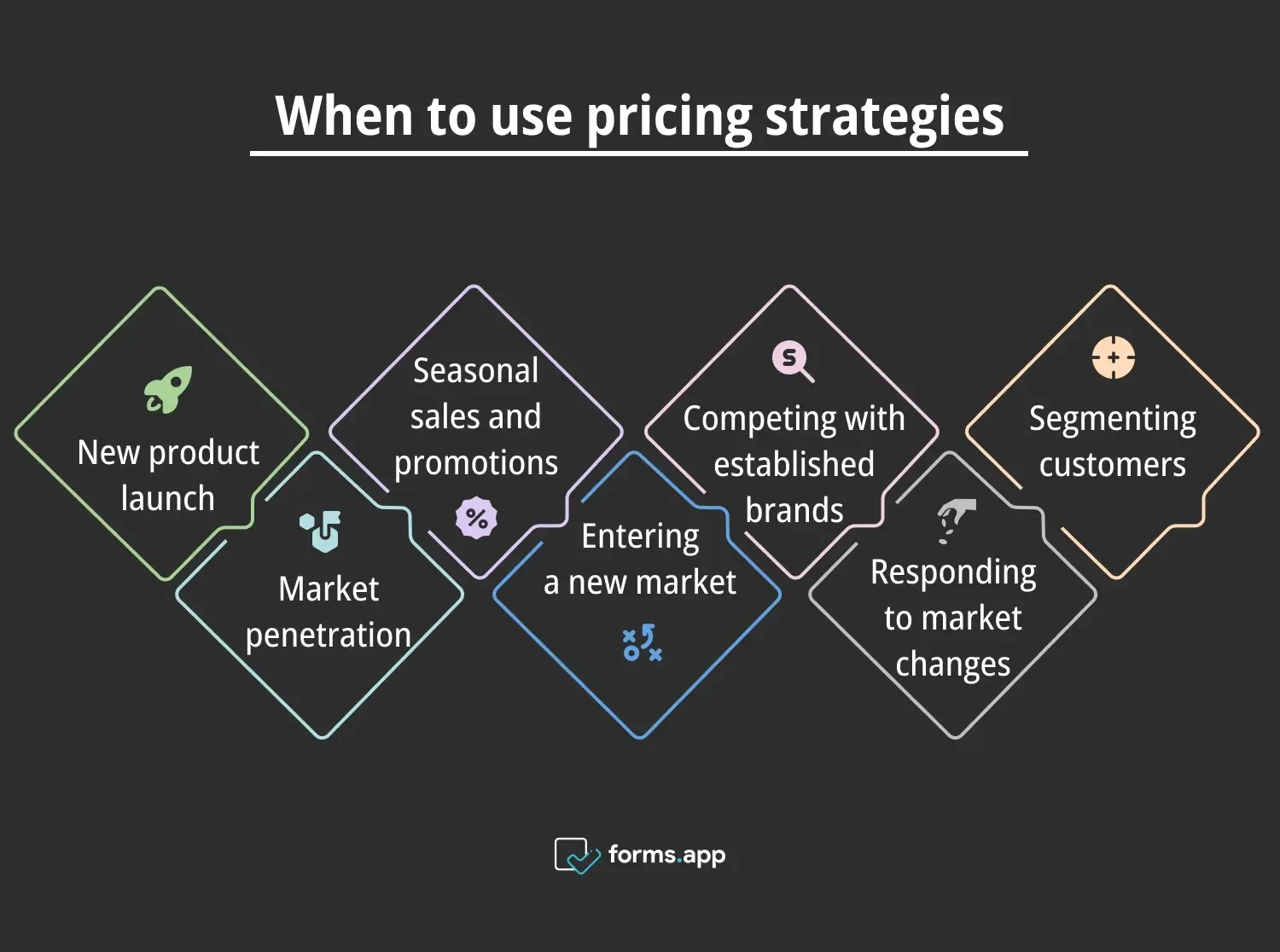
Right times to use pricing strategies
⏰New product launch
When you are launching a new product, choosing the right pricing strategy is crucial. It can determine your product’s market acceptance and success. A well-planned pricing strategy helps in setting a price reflecting your product’s value, covers costs, and attracts new customers.
⏰Market penetration
You can use market penetration strategies when your business aims to enter or expand its presence in a market. This involves setting competitive prices to attract customers from existing competitors. The goal is to quickly increase market share and establish a strong customer base.
⏰Seasonal sales and promotions
Seasonal sales and promotions are ideal opportunities to use strategic pricing. During holidays or special events, your business can attract customers by offering discounts and special deals. These pricing strategies leverage the demand during these periods. For instance, holiday sales or back-to-school promotions can drive significant traffic and boost sales.
⏰Entering a new market
When entering a new market, your business needs to carefully consider its pricing strategy. The right approach can help establish a brand and attract local customers. For instance, businesses might use market-based pricing to align with local economic conditions and consumer demand.
⏰Competing with established brands
If you want to compete with established brands, you need a thoughtful pricing strategy. New companies should offer compelling values to attract customers away from well-known competitors. Competitive pricing strategies, such as offering lower prices or better value, can be effective.
⏰Responding to market changes
Market conditions can change rapidly, and your business must adapt its pricing strategies accordingly. For example, during economic downturns, customers may become more price-sensitive, prompting businesses to lower prices or offer more value. On the contrary, your business might raise prices to maximize profits if you are in a booming economy.
⏰Targeting different customer segments
Different customer segments may have varying price sensitivities and preferences. Businesses can use segmented pricing strategies to address these different needs. For example, premium pricing can target high-income customers seeking luxury, while economy pricing can appeal to budget-conscious consumers.
Examples of pricing strategies
Having seen the different suitable environments/contexts for different pricing strategies, we will now take a look at pricing strategy examples from well-known companies. Seeing how these companies use marketing/pricing strategies will help you get a clearer understanding of the subject.
Apple Inc. - premium pricing strategy
Apple Inc. uses a premium pricing strategy to reinforce its brand image as a producer of high-quality, innovative products. By setting high prices for its products, Apple creates a perception of exclusivity and superior value. This strategy is specific for a target audience willing to pay a premium for cutting-edge technology and design.
Airbnb - dynamic pricing strategy
Airbnb uses dynamic pricing to optimize rental prices based on demand, seasonality, and local events. The platform’s pricing algorithms analyze data to adjust prices in real-time. This ensures that hosts can maximize their earnings while providing competitive rates to guests. This strategy allows Airbnb to respond quickly to market changes and leverage high-demand periods.
Steam - geographic pricing strategy
Steam, the popular game client, uses geographic pricing to adjust game prices based on the user’s location. This strategy considers economic conditions, currency differences, and purchasing power. By setting different prices in various regions, Steam maximizes sales globally, addressing diverse markets while maintaining competitiveness and revenue optimization.
Advantages and disadvantages
We have already briefly mentioned the advantages and disadvantages of each pricing strategy. As we have mentioned, each pricing strategy has its values and advantages. However, you should be cautious and consider some aspects before using them in your business:
Advantages
👍Maximize profitability: Effective pricing strategies in marketing help businesses maximize profits by setting prices that reflect the value provided and cover all costs. Businesses can optimize prices by understanding market demand and customer willingness to pay to generate the highest possible revenue.
👍Enhance market position: Strategic pricing can enhance a business’s market position by differentiating its products from competitors. Premium pricing, for example, positions a product as high-quality and exclusive, attracting customers seeking superior value.
👍Increase sales volume: Pricing strategies can increase sales volume by attracting more customers. Penetration pricing, for instance, sets low initial prices to gain market share and encourage trial purchases quickly. Bundle pricing, on the other hand, offers attractive deals on multiple products, boosting overall sales.
👍Improve customer satisfaction: Well-designed pricing strategies can improve customer satisfaction by providing perceived value and meeting customer expectations. Value-based pricing, for example, ensures that customers feel they are getting their money’s worth for the benefits provided.
👍Facilitate market entry: Pricing strategies can facilitate market entry by helping businesses attract customers in new markets. Penetration pricing, which involves initially setting low prices, can quickly build a customer base and establish a market presence.
👍Enhance customer loyalty: Pricing strategies can enhance customer loyalty by creating a sense of value and fairness. Consistent and transparent pricing builds trust and encourages repeat purchases. Loyalty programs and special discounts for returning customers can also strengthen customer relationships.
Disadvantages
👎Risk of price wars: Competitive pricing strategies can lead to price wars, where businesses continually lower prices to outdo each other. While this may attract customers in the short term, it can erode profit margins and harm long-term sustainability.
👎Customer perception issues: Inconsistent or poorly communicated pricing strategies can lead to customer perception issues. Frequent price changes or hidden fees can create confusion and erode trust. Customers may feel deceived if they perceive that prices are manipulated unfairly.
👎Implementation challenges: Implementing effective pricing strategies can be complex and resource-intensive. It requires thorough market research, cost analysis, and continuous monitoring to ensure prices remain competitive and profitable. You can look at market research questions to avoid this.
Frequently asked questions
Last but not least, let’s look at some of the most frequently asked questions about the subject. Here, we will find answers to some of the common queries and help you better understand the subject.
The best pricing strategy for a new product depends on market conditions and business goals. Penetration pricing helps gain market share quickly by setting low initial prices. Skimming pricing maximizes early profits with high prices for innovative products. Understanding customer preferences and competitor pricing is essential to choose the right approach for your situation.
Value-based pricing is effective because it sets prices based on the perceived value to the customer. This approach allows businesses to charge higher prices for products that offer unique benefits and meet customer needs. By focusing on customer value, businesses can maximize profitability and enhance customer satisfaction, creating a strong competitive advantage in the market.
Determine the right price by conducting market research, analyzing costs, and understanding customer value perceptions. Consider competitor prices and your business objectives. Use cost-plus pricing for straightforward calculations, value-based pricing for premium products, or competitive pricing for market alignment. Testing and adjusting prices based on feedback and market reactions ensures optimal pricing.
Key points to take away
In conclusion, pricing strategies are essential tools for your business’ success. They help you set the right prices to attract customers, maximize profits, and stay competitive. Understanding different pricing strategies and how to use them is crucial for making informed decisions.
This article covered the importance and types of pricing strategies when to use them, and how to build them. We also explored various real-life examples and discussed the advantages and disadvantages of the pricing strategies. Last but not least, we answered some of the most frequently answered questions about the subject. Use pricing strategies in your business now!
forms.app, your free form builder
- Unlimited views
- Unlimited questions
- Unlimited notifications

